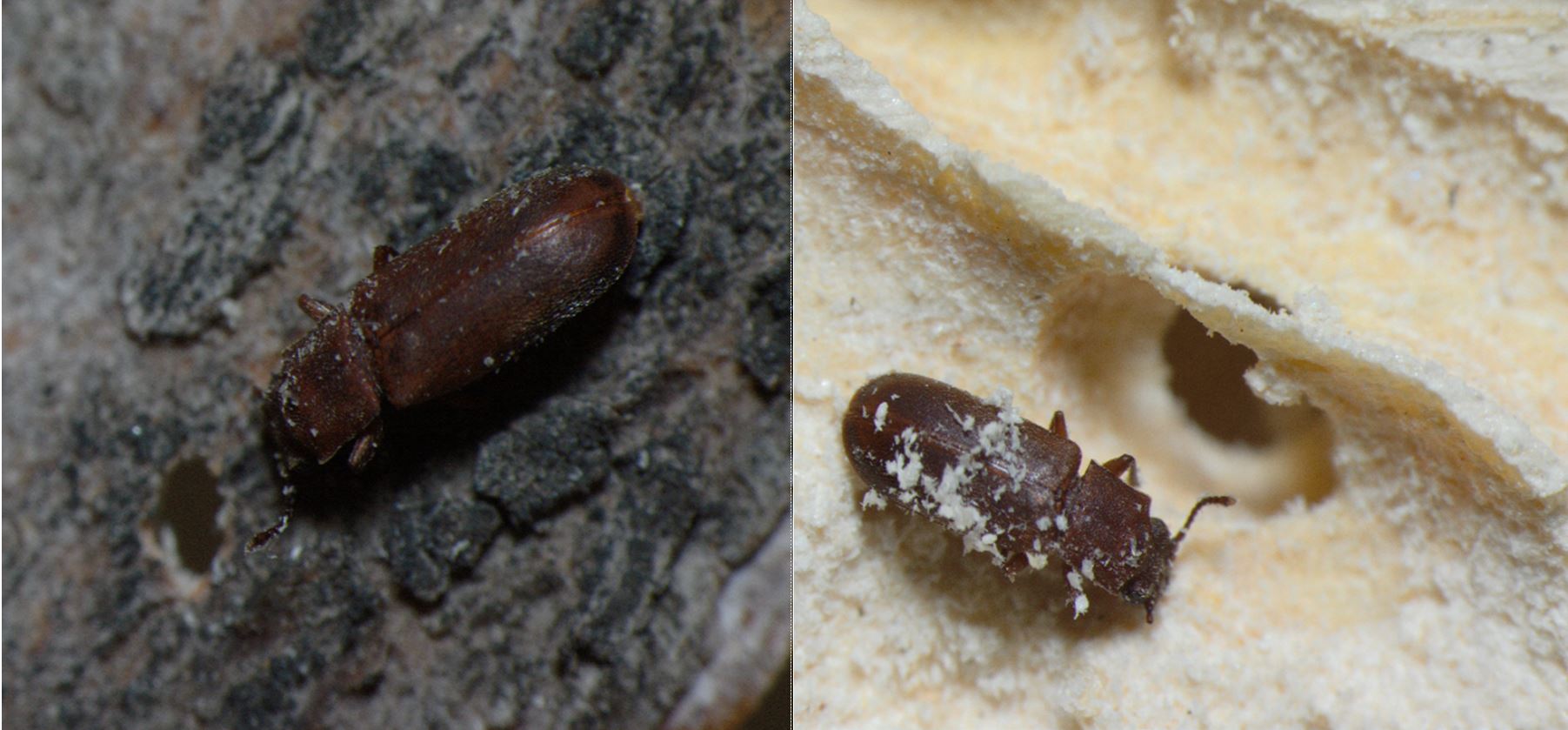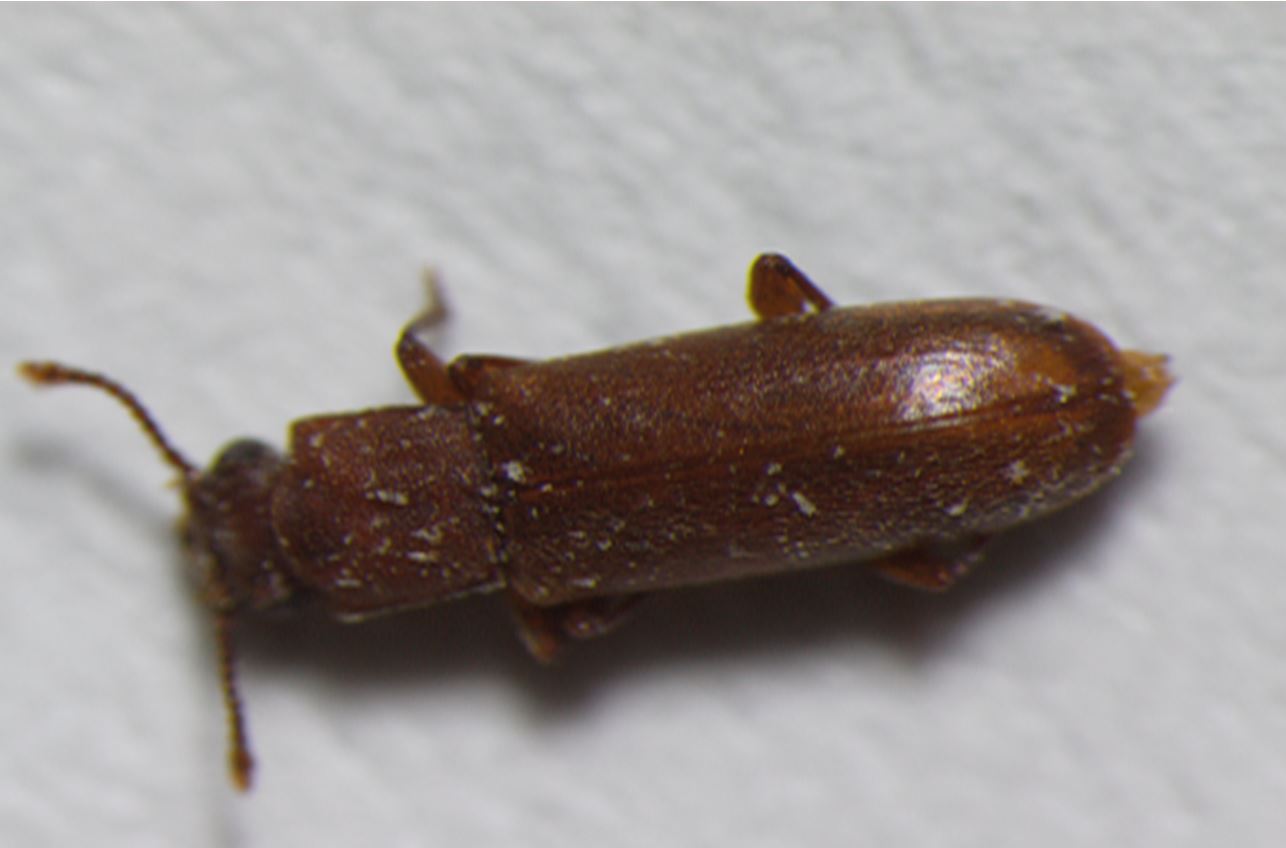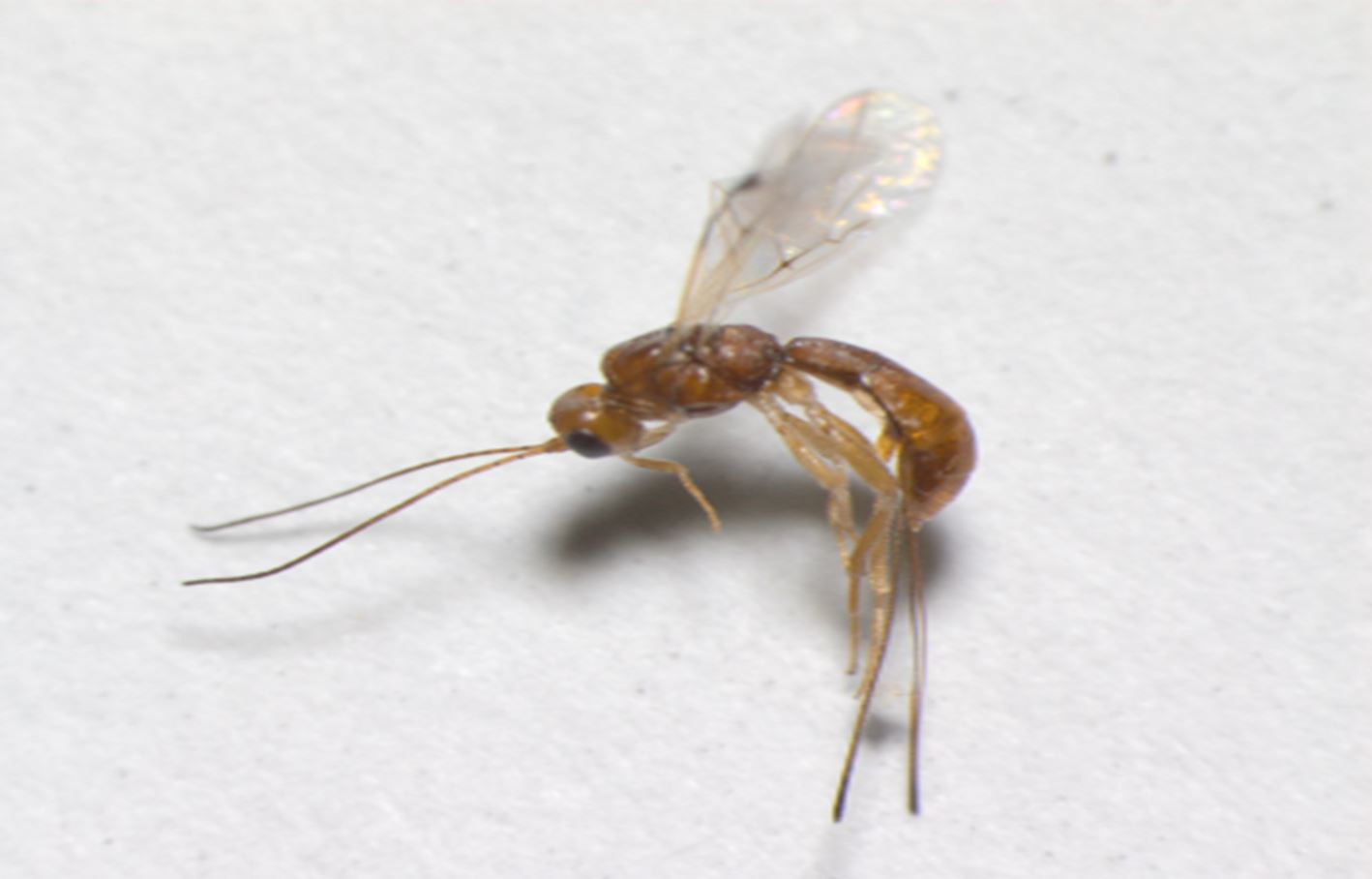İ. Özgen, A. Beyarslan, E. Ruizzer, A. Topdemir
ABSTRACT In the present paper, Monolexis fuscicornis Förster, 1862 (Hymenoptera, Braconidae, Doryctinae) is recorded in Turkey for the second time and it is documented as parasitoid of Trogoxylon impressum (Comolli, 1837) (Coleoptera: Bostrichidae), firstly pest T. impressum (Comolli, 1837) record on fig plants. This damage to the fig plant and nutritional behavior with exit holes was observed for the first time with this work. In additionally, this record was firstly reported in the Southeast Anatolia region of the pest. Harmful has the potential to cause significant damage to fig plants over the years. It is necessary to studies whether the natural enemy detected on the pest is under the pressure of this pest. In this study, M. fuscicornis Förster,1862 is recognised as larva-pupa parasitoid of T. impressum, important pest in fig tree plantations in Turkey. This interaction could have significant implication in biodiversity conservation and pest management. Hence, this new parasitoid-host interaction on fig plants has highly significance in pest manage-ment and biocontrol, because it is thought that the damage will increase in the future.
Keywords: parasitoid; new record; Middle East; Ficus carica; host; biocontrol; pest management.
View full article (HTML)
The important record of Monolexis Fuscicornis forster, 1862 (Hymenoptera, Braconidae, Doryctinae) in Turkey with notes on Trogoxylon Impressum (Comoli, 1837)
İ. Özgen1,*, A. Beyarslan2, E. Ruizzer3, A. Topdemir1
1Fırat Univesity, Engineering Faculty, Bioengineering Department, Elazığ, Turkey
2Bitlis Eren University, Biology Department, Turkey
3World Biodiversity Association onlus c/o Museo Civico di Storia Naturale Lungadige Porta Vittoria, Verona, Italia
*E-mail: inancozgen@gmail.com
Received: May 26, 2018. Revised: Jul. 30, 2018. Accepted: Sep. 19, 2018. Published online: July 17, 2019
ABSTRACT In the present paper, Monolexis fuscicornis Förster, 1862 (Hymenoptera, Braconidae, Doryctinae) is recorded in Turkey for the second time and it is documented as parasitoid of Trogoxylon impressum (Comolli, 1837) (Coleoptera: Bostrichidae), firstly pest T. impressum (Comolli, 1837) record on fig plants. This damage to the fig plant and nutritional behavior with exit holes was observed for the first time with this work. In additionally, this record was firstly reported in the Southeast Anatolia region of the pest. Harmful has the potential to cause significant damage to fig plants over the years. It is necessary to studies whether the natural enemy detected on the pest is under the pressure of this pest. In this study, M. fuscicornis Förster,1862 is recognised as larva-pupa parasitoid of T. impressum, important pest in fig tree plantations in Turkey. This interaction could have significant implication in biodiversity conservation and pest management. Hence, this new parasitoid-host interaction on fig plants has highly significance in pest manage-ment and biocontrol, because it is thought that the damage will increase in the future.
Keywords: parasitoid; new record; Middle East; Ficus carica; host; biocontrol; pest management.
INTRODUCTION
Doryctinae is one of the most specified subfamilies in Braconidae (Shenefelt and Marsh, 1976). Most Doryctinae species for which the biology is known are idiobiont ecto-parasitoids of several wood-boring beetle larvae (Marsh, 1997; Yu et al., 2012).
Doryctine species are parasitoids of bark beetles, pest in agriculture and forest context, playing a fundamental role in pests control (Shaw and Huddleston, 1991).
At the moment, 67 species are reported for Turkey (Beyarslan and Aydogdu, 2013; Beyarslan, 2015). Monolexis fuscicornis Förster, 1862 is recorded in Turkey for the second time and it was recognised as parasitoid of Trogoxylon impressum (Coleoptera: Bostrichidae). The family of the Lyctidae comprises worldwide approximately 75 species of small, brownish beetle, which exist on dry material, such as wood, stored grain, herbs and roots (Ross, 1952).
The Lyctidae are also known as powderpost beetles (Halperin and Geis, 1999). T. impressum parasites several trees and shrubs species, such as Acacia albida, Ceramnia siliqua, Cercis siliquastrum, Dalbergia sissoo, Ficus carica, Ficus intusa, Ficus sycomorus, Mangifera indica, Pistacia lentiscus, Pistacia vera, Punica granatum, Quercus calliprinos, Junglans sp., Populus (Salicaceae), Vitis vinifera, Schinus terebinthifolius, Zizyphus spin addition to Eucalyptus spp. in Israel and the other countries (Adlbauer 1998; Halperin and Geis, 1999; Bahillo de la Puebla et al., 2007; Baena and Zuzarte, 2013), and is presumably polyphagous.
The larvae feed preferentially in dry sapwood, and several generations may succeed each other in the same piece of wood (Bahillo de la Puebla et al., 2007). In Turkey, only few species of Braconidae have been reported as natural enemies of plantation pests; Güçlü and Özbek (2011) recognised Eubazus (Eubazus) pallipes as para-site of Lyctus brunneus, L. linearis, L. planicollis, (Coleoptera: Bostrichi-dae). However, no species have been recorded, as natural enemies of the T. impressum on fig plants. In this study, M. fuscicornis Förster, 1862 is recognised as larva-pupa parasitoid of T. impressum, important pest in fig tree plantations in Turkey. This interaction could have significant implication in biodiversity conserva-tion and pest management.
MATERIALS AND METHODS
Sampling campaign was carried out between February and July, both in 2016 and 2017. Perennial fig trees, dying because of the parasites, were cut and reduced into pieces. Wood pieces were stored in emergence chambers.
The rearing procedure was carried out between February 15, 2016 and July 30, 2017. Wood samples were checked weekly and the emerging individuals were collected. T. impressum pupation chambers were marked, emergence holes of both external barks of the plant, through which adult T. impressum and M. fuscicornis were photographed microscope and recorded.
RESULTS AND DISCUSSION
Trogoxylon impressum (Comolli, 1837) and the parasitoid Monolexis fuscicornis Förster, 1862 were obtained during 2017; no parasitoid species were detected on this species in the previous year.
Trogoxylon impressum, Comolli, 1837
Material examined: Diyarbakır, Eğil, Turkey, 28.04.2017, 20 spec. Ficus carica, ex larvae, Leg. Özgen. Note: species so far recorded on Turkey only for Antalya (Anonymous, 2017).
Distribution: Mediterranean region, Middle East, Turkmenistan, Caucasus. Introduced into USA, Argentina and Turkey (Antalya) (Anonymous, 2017; Hagstrum and Subramanyam, 2009; Gerberg, 1957).
Remarks: See feeding of the species around the exit holes on the outer bark of the fig plant and the inner parts and the white dust it secretes (Fig. 2). This dust is also found on the elytra of this species.

Figure 2 – Feeding and powder on Ficus carica plant upper and inner shell of powderpost beetle Trogoxylon impressum Comolli, 1837.
Monolexis fuscicornis, Förster, 1862 (Fig. 3).
Material examined: Diyarbakır, Eğil, Turkey, 30.06.2017, 3 exc. Ficus carica, leg. Özgen.
Distribution: Düzce (Yalçın et al., 2017). In this species, host, host food, biology and general distributions obtained up to now are given below.
Diagnosis: body length: 3.3 mm, antenna length 2.75 mm, forewing length: 2.8 mm mesosoma length: 1.1 mm, metasoma length: 1.75 mm, ovipositor sheath length: 2.3 mm, head transverse, vertex transversely rugose, antennae 25-segmented, first flagellar segment shorter than 2nd segment, mesonotum with dense granulose sculpture, radial cell of forewing not reduced, recurrent vein postfurcal, nervulus almost interstitial, first abdominal tergite slightly longer than its width at apex, only 1st and 2nd abdominal tergites, except for their apices, longitudinally rugose, body color brownish yellow; eyes black, wings membrane hyaline, pterosigma and veins dark.
Host species: Amphicerus bimaculatus [host plant: Punica granatum]; Chaetoptelius vestitus [host plant: Pistacia vera]; Enneadesmus trispinosus [host plant: Tamarix sp.]; Heterobostrychus brunneus [host plant: Triplochiton scleroxylon]; Laemophloeus capensis; Lyctus brunneus [host plant: Xanthophyllum macintyrrii]; Lyctus linearis; Lyctus parallelocollis [host plant: Eucalyptus maculata]; Lyctus planicollis; Mesosa curculionoides; Minthea rugicollis; Phloeotribus scarabaeoides [host plant: Ceratonia siliqua]; Scobicia chevrieri [host plant:Ceratonia siliqua, Pistacia vera]; Scobicia pustulata; Sinoxylon ceratoniae [Cercis siliquastram]; Sinoxylon sexdentatum; Sternidius alpha [host plant: Robinia pseudoacacia]; Trogoxylon; Trogoxylon parallelopipedum.
General distribution: Argentina, Australia, Austria, Azerbaijan, Brazil, Bulgaria, Canada, Costa Rica, Check Republic, France, Georgia, Germany, Hungary, Ireland, Israel, Italy, Japan, Malaysia, Spain, Tunisia, Turkme-nistan, United Kingdom, U.S.A. (Anonymous, 2018).
CONCLUSIONS
In view of results, this record was firstly record in the Southeast Anatolia region of the pest. Harmful has the potential to cause significant damage to fig plants over the years. It is necessary to studies whether the natural enemy focused on the pest is under the pressure of this pest. In this study, M. fuscicornis Förster,1862 is recognised as larva-pupa parasitoid of T. impressum, important pest in fig tree plantations in Turkey. This results could have significant implication in biodiversity conservation and pest management.
Hence, this new parasitoid-host interaction on fig plants has highly significance in pest management and biocontrol, because it is thought that the damage will increase in the future.
REFERENCES
Anonymous (2017) https://www.flickr.com /photos/30703260@N08/24968105786. Date: 01.08.2017.
Anonymous (2018). Fauna Europaea https://fauna-eu.org. Date: 01.01.2018.
Adlbauer, K. (1998).
Die Splintholzkäferfauna der Steiermark (Coleoptera, Lyctidae). Mitteilungen Landesmuseum Joanneum, Zoologie, 51: 55-58.
Baena, M. & Zuzarte, A.J. (2013). Contribución al estudio de los Bostríquidos de Portugal y actualización del catálogo de la fauna ibérica (Coleoptera, Bostrichidae). Zoologica baetica, 24: 25-51.
Bahillo de la Puebla, P., López-Colón, J.I. & Baena, M. (2007). Los Bostrichidae Latreille, 1802 de la fauna íbero-balear (Coleoptera). Heteropterus Revista de Entomologia, 7: 147-227.
Beyarslan, A. & Aydogdu, M. (2013). Additions to the rare species of Braconidae fauna (Hymenoptera: Braconidae) from Turkey. Mun.Ent.Zool., 8: 369-374.
Beyarslan, A. (2015). A faunal study of the subfamily Doryctinae in Turkey (Hymenoptera: Braconidae). Turk.J.Zool., 39: 126-143.
Gerberg, E.J. (1957). A revision of the new world species of powder-post beetles belonging to the family Lyctidae. Technical Bulletin, No. 1157.
Güçlü, C. & Özbek, H. (2011). A contribution to the knowledge of the subfamily Brachisitinae (Hymenoptera: Braconidae) in Turkey. J.Entomol.Res.Soc., 13 (3): 15-26.
Hagstrum, D.W. & Subramanyam, B. (2009). Stored-product insect resource. AACC International, Inc., St. Paul, Minnesotta, USA, 508 p.
Halperin, J., Geis, K.U. (1999). Lyctidae (Coleoptera) of Israel, their damage and its prevention. Phytoparasitica, 27(4): 257-262.
Marsh, P.M. (1997). Subfamily Doryctinae. In: Wharton, R.A., Marsh, P.M., Sharkey, M.J. (Eds.). Manual of the new world genera of the family Braconidae (Hymenoptera): subfamily Doryctinae. Washington, The International Society of Hymenopterists, pp. 206-233.
Ross, H. Arnett, Jr. (1952). Notes on Lyctidae (Coleoptera). USDA – ARS, Bulletin No. 844.
Shaw, M.R. & Huddleston, T. (1991). Classification and biology of braconid wasps. In: W.R. Dolling and R.R. Askew (Eds.), Handbooks for the Identification of British Insects, Vol. 7, pp. 1-126, Royal Entomological Society of London, London.
Shenefelt, R.D. & Marsh, P.M. (1976). Braconidae. Doryctinae. In: Ferrière C, van der Vecht J. (Eds.), Hymenopterorum Catalogus (nova editio) Pars 13. The Hague, Netherlands: Uitgeverij Dr. W. Junk, pp. 1263-1424.
Yalçın, M., Yüksel, B., Akçay, Ç., Akay, E. & S. Akbulut, S. (2017). Evaluation of Monolexis fuscicornis (Hymenoptera) as parasite of Lyctus brunneus (Coleoptera) in parquets. İleri Teknoloji Bilimleri Dergisi, 6(3): 1053-1059.
Yu, D.S., van Achterberg, C. & Horstmann, K. (2012). Ichneumonoidea 2011 (Biological and taxonomical information). Taxapad Interactive catalogue. Available at www.taxapad.com.





